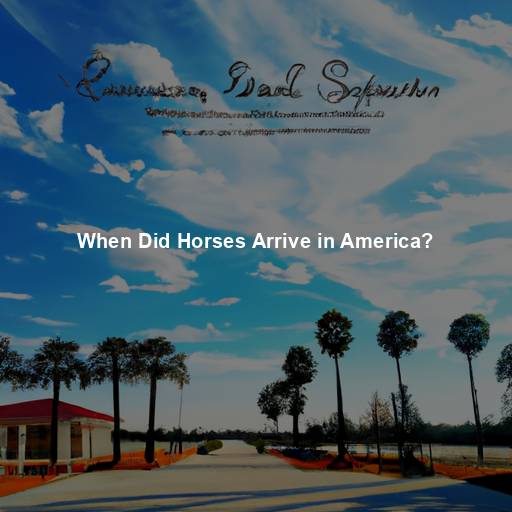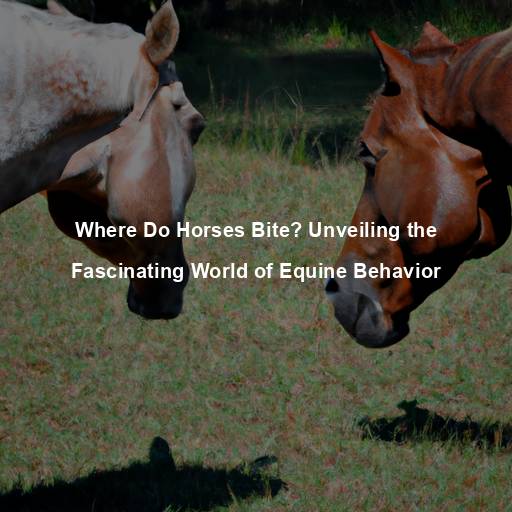When Did Horses Arrive in America?
Last Updated on July 9, 2023 by Evan
Contents [hide]
- 1 The Arrival of Horses: A Significant Turning Point in American History
- 1.1 The Pre-Columbian Era: A Horseless America
- 1.2 The Spanish Conquistadors: Unleashing the Power of Horses
- 1.3 The Spread of Horses: A Continent Transformed
- 1.4 Cultural Assimilation and Adaptation
- 1.5 The Role of Horses in Native American Economy
- 1.6 The Legacy of Horses in Modern America
- 1.7 Preservation of Horse Breeds
- 1.8 Challenges and Controversies
- 1.9 The Horse as a Symbol of Resilience and Freedom
- 1.10 Continuing the Legacy
- 2 FAQs: When Did Horses Get to America?
- 2.1 When were horses brought to America?
- 2.2 How did horses arrive in America?
- 2.3 Where did the horses come from?
- 2.4 What was the impact of horses on Native American tribes?
- 2.5 Did Native Americans have horses before the arrival of Europeans?
- 2.6 How did the presence of horses impact American society?
- 2.7 Are there still wild horses in America today?
- 2.8 How have horses evolved in America since their arrival?
The Arrival of Horses: A Significant Turning Point in American History
The introduction of horses to America sparked a seismic shift that reverberated across the land and through the annals of time. Majestic and untamed, these noble beings forged an unbreakable bond with Native Americans, forever altering the landscape of their existence. With each thunderous hoofbeat, a new chapter of history unfolded, weaving a tapestry of intrigue and awe. Embark on a journey through time as we unravel the enigmatic story of equine arrival in the New World and the bewildering impact it had on the indigenous people who called it home.
The Pre-Columbian Era: A Horseless America
Long before the rhythmic hoofbeats danced upon the soil, the Native American tribes of North America reveled in a tapestry of traditions and customs. Yet, awe-struck and perplexed they stood when these majestic beings appeared, for the horse, once a resident of their lands, had vanished into the mists of time, leaving behind a void of equine absence. It was through the veiled curtain of European exploration and colonization that these noble creatures were once more breathed into existence upon the ancestral continent, entwining their presence into the very fabric of daily existence.
The Spanish Conquistadors: Unleashing the Power of Horses
In the era of historical transformation, a pivotal moment in time occurred in the year 1492. Like a flame ignited in the depths of curiosity, Christopher Columbus sailed towards the Caribbean islands, paving the way for an unprecedented chapter of European colonization in the vast expanse of the Americas. As the wind whispered of newfound lands and tantalizing opportunities, the Spanish conquistadors embarked on intrepid expeditions, their hearts brimming with anticipation and uncertainty. Amidst this maelstrom of exploration and exploitation, a remarkably distinctive and majestic creature made its triumphant return to the Western Hemisphere – the noble and awe-inspiring horse.
In a remarkable turn of events in the year 1519, the intrepid Hernán Cortés embarked on a historic journey to the bountiful land of Mexico. Alongside him, he carried a precious cargo that would forever alter the course of history – a small group of majestic horses. These magnificent creatures, absent from the continental Americas for centuries, arrived with an awe-inspiring grandeur, leaving the indigenous peoples of Mexico perplexed and astounded. The Aztecs, unaccustomed to encountering such formidable beings, were captivated by their velvety strength, phenomenal speed, and graceful movements.
The Spread of Horses: A Continent Transformed
With the triumphant arrival of the Spanish conquistadors and their entourage of traders and settlers, the winds of change swept across the vast landscapes of the Americas. Horses, majestic creatures of unparalleled beauty, became the mesmerizing ambassadors of transformation, galloping through the veins of a continent eager for novelty. As their hooves rhythmically struck the earth, indigenous tribes found themselves engulfed in a bewilderment of possibilities and endless perplexities, as their accustomed way of life underwent a remarkable metamorphosis.
Transportation and Trade
Horses revolutionized transportation for Native American tribes, enabling them to travel longer distances with greater speed and efficiency. The use of horses as pack animals allowed for the transportation of heavier loads, enhancing trade networks and facilitating the exchange of goods between tribes. This newfound mobility opened up new horizons for exploration and expansion.
Hunting and Gathering
Throughout history, the majestic presence of horses has inspired a profound transformation in Native American hunting tactics. The harmonious alliance between these noble creatures and tribes bestowed them with an extraordinary edge in their quest for sustenance. Embracing the blessings of equine companionship, hunters harnessed the galloping splendor, embarking on thrilling pursuits that spanned vast landscapes. This thrilling metamorphosis ushered in a captivating era of innovative strategies, as the indigenous people embarked on an enigmatic journey towards optimizing the unparalleled grace and dexterity of their newfound allies.
Warfare and Conflict
The arrival of horses revolutionized the face of Native American warfare, inducing a wave of transformative changes. The tribes fortunate enough to acquire these majestic creatures experienced a paradigm shift, gaining a substantial upper hand over their counterparts who remained devoid of this newfound advantage. Mounted warriors emerged as swift, nimble, and formidable forces, capable of launching fierce assaults that left their foes awestruck. This pivotal shift in dynamic reshaped intertribal conflicts, paving the way for the emergence of influential equestrian warriors, and catalyzing the reconfiguration of tribal alliances.
Cultural Assimilation and Adaptation
The arrival of horses in Native American communities ignited a whirlwind of transformative experiences. With these majestic creatures, tribes found themselves traversing uncharted territories, forging unexpected alliances, and partaking in a new era of expanded trade networks. As the tribes’ hearts raced alongside the pounding hooves, the very fabric of their traditions and customs unraveled and rewove itself into a tapestry of perplexing beauty. The once familiar rhythms of their lives now danced to the syncopated beat of these equine gifts, forever changing the course of history.
Horse-Related Ceremonies and Rituals
With the integration of horses into their daily lives, Native American tribes developed new ceremonies and rituals centered around these magnificent creatures. Horses became symbols of power, strength, and spirituality, and were often incorporated into religious ceremonies, dances, and storytelling traditions. These rituals helped foster a deeper connection between humans and horses, honoring the role they played in the tribe’s survival and prosperity.
Art and Symbolism
Throughout Native American history, horses have left an indelible mark on the world of art and symbolism. With their majestic arrival, artists found themselves captivated by the enigmatic allure of these magnificent creatures, leading to their depiction in an array of artistic forms such as masterful paintings, intricate carvings, and exquisite pottery. Beyond their physicality, horses became profound metaphors, embodying the ideals of freedom, resilience, and the nomadic spirit ingrained within countless Native American tribes. Through the artwork they inspired, horses inextricably wove themselves into the rich cultural tapestry, forever etching their hoofprints upon the native lands.
The Role of Horses in Native American Economy
The introduction of horses had a profound effect on the economic systems of Native American tribes. The newfound mobility provided by horses allowed tribes to expand their trading networks and engage in long-distance commerce. Horses became highly valued commodities and were often exchanged as a form of currency or used in barter systems.
Horse-Related Trade Networks
The fascinating interweaving of horses within Native American economies birthed a kaleidoscope of intricate trade networks. With horses gaining coveted status among nearby tribes, those possessing these majestic creatures enjoyed a tangible advantage in the realm of commerce. Transforming into a prized currency, equines became the key to acquiring a cornucopia of goods, ranging from furs and sustenance to vital tools and precious resources. Consequently, tribes with an abundant steed surplus thrived, accumulating a wealth that bestowed them with remarkable sway over their neighboring communities.
Horse Breeding and Sales
Recognizing the economic potential of horses, some Native American tribes began selectively breeding horses to produce specific traits and characteristics. This practice allowed them to develop unique horse breeds that were highly sought after in trade. Horse sales became a lucrative business for some tribes, providing them with a sustainable source of income and further strengthening their economic position within the region.
The Legacy of Horses in Modern America
The profound influence that horses have had on Native American cultures and the vast continent of America is unmistakably palpable even in the present day. The equine creatures have managed to carve a permanent space in the collective consciousness, encompassing notions of liberation, exploration, and a deep bond with the untamed wilderness. Undeniably, the horse stands tall as an eternal emblem of the enchanting American West and its storied heritage.
Horse-Riding Traditions
For countless generations, the timeless art of horse riding has woven its way into the tapestry of Native American culture, leaving behind a legacy of captivating traditions. From ancient times to the present day, the sacred bond between horse and rider has endured, becoming an integral part of the vibrant cultural fabric of Native American communities. Across powwows, rodeos, and spirited equestrian gatherings, tribal members exude an enigmatic magnetism as they showcase their awe-inspiring horsemanship prowess, encapsulating the essence of their rich heritage.
Equine-Assisted Therapy and Healing
Over the past few years, a fascinating phenomenon has taken shape – the understanding that horses can provide profound healing and personal development experiences. Equine-assisted therapy has become a magnetic force for individuals seeking solace and growth. Interestingly, Native American communities have wholeheartedly welcomed this approach, harnessing the innate bond they share with horses to nurture overall physical, emotional, and spiritual harmony.
Preservation of Horse Breeds
The rich tapestry of Native American culture weaves a tale of deep entanglement with the noble creatures that are horses. An intricate dance of preservation and evolution took shape as these tribes embraced the equine companions that fate presented. Assiduously honing their skills, the tribes skillfully manipulated the intricate strands of horse genetics, crafting unique and resilient breeds entwined with the essence of their respective lands. The legacy of this symbiotic bond lives on to this day, as the resilient Appaloosa and the regal American Indian Horse stand as living testaments to the perplexing and splendid tapestry of our nation’s history.
Appaloosa: A Treasured Breed
Step into the fascinating world of the Appaloosa horse – an enchanting equine with a coat like no other! With origins deeply ingrained in the rich tapestry of Native American culture, these majestic creatures were nurtured by the revered Nez Perce tribe, esteemed for their mastery of horsemanship. Embodying resilience, intelligence, and adaptability, the Appaloosa horses became prized companions in the tribe’s multifaceted endeavors, be it the thrill of the hunt, the intensity of battle, or the efficiency of transportation. Prepare to be captivated by the allure of these magnificent steeds as we unravel their extraordinary journey.
American Indian Horse: A Symbol of Resilience
The winds of history have carried the hoofprints of a remarkable breed, known as the American Indian Horse, for centuries. Tracing its lineage to the equine companions brought by Spanish conquistadors, this breed found its place in the hearts of Native American tribes, particularly those dwelling in the vast expanse of the Great Plains. These magnificent creatures were revered for their unwavering strength, unyielding endurance, and unparalleled adaptability to the harshest of environments. Truly a testament to the timeless connection between Native Americans and their equine partners, dedicated efforts continue to safeguard and celebrate the legacy of the American Indian Horse in the modern world.
Challenges and Controversies
Throughout history, the relationship between Native American tribes and horses has been a captivating saga of triumphs and tribulations. These majestic creatures have undoubtedly offered a plethora of advantages, yet at the same time, their existence has not been devoid of complications and debate. As the pages of time turn, the story of horses and Native Americans continues to unfold, an enigmatic tale filled with moments of brilliance and bewilderment.
Environmental Impact
The introduction of horses to North America had a significant impact on the continent’s ecosystems. Horses, being non-native species, can have detrimental effects on native plant and animal populations. Overgrazing by horses can lead to the degradation of rangelands and disrupt the balance of local ecosystems. Efforts are underway to manage wild horse populations and mitigate their environmental impact, while also respecting the cultural significance of these animals to Native American tribes.
Loss of Traditional Knowledge
As Native American tribes adopted and integrated horses into their cultures, some traditional knowledge and practices related to horse husbandry and horsemanship began to decline. With the passage of time, the younger generations may have less exposure to the traditional teachings and skills associated with horses. Efforts are being made to preserve and revitalize these practices through cultural education programs and intergenerational knowledge sharing.
The Horse as a Symbol of Resilience and Freedom
Throughout history, the presence of horses has woven an intricate tapestry of significance within Native American communities. These majestic creatures embody not only resilience and freedom, but also serve as a powerful link to the ancestral past. A testament to the remarkable strength and adaptability of indigenous peoples, horses have stood as unwavering allies, accompanying and empowering Native Americans in their daily activities, rituals, and sacred ceremonies. Their enduring bond with these noble equines is a testament to the profound and captivating interplay of culture, heritage, and the inherent spirit of these communities.
Equine-Assisted Healing and Reconnection
In a world full of fragmented connections, there exists a captivating relationship between Native Americans and horses that cannot be ignored. This unbreakable bond has given rise to a remarkable solution – equine-assisted programs, serving as a pathway towards both healing and cultural revitalization. Guided by the wisdom of generations past, these programs offer individuals and communities a transformative journey, where they can engage with these majestic creatures within a therapeutic and educational environment. From the soothing rhythm of horseback riding to the intimate act of grooming, these activities empower participants to not only reclaim their cultural identity but also forge a profound connection to their ancestral traditions.
Continuing the Legacy
The mesmerizing bond between Native American cultures and horses is an everlasting tale, woven into the tapestry of their existence, continuously shape-shifting and reinventing itself with time. As the wind whispers ancient wisdoms, the Native American individuals and communities ardently embrace their sacred duty to safeguard their horse-centered heritage, ensuring its endurance amidst the tides of modernity. Through their tireless efforts, they strive to harmonize the fates of equines and humans, nurturing a bond that transcends time and resonates with the beating hearts of both horse and rider.
Cultural Events and Celebrations
Across the United States, various cultural events and celebrations pay homage to the enduring relationship between Native Americans and horses. Powwows, rodeos, and horse races provide opportunities for tribes to showcase their horsemanship skills, share stories, and celebrate their shared history. These events serve as reminders of the deep-rooted connection between Native American communities and their equine companions.
Advocacy and Preservation Efforts
Native American tribes and organizations are actively involved in advocating for the welfare and protection of horses. They work to ensure that horses are treated with respect and dignity, whether in domestic settings or in the wild. These efforts include supporting legislation that safeguards the rights of horses, promoting responsible horse ownership practices, and participating in conservation programs to preserve wild horse populations and their habitats.
FAQs: When Did Horses Get to America?
When were horses brought to America?
The story of horses in America unfolds like a tapestry woven with threads of Spanish conquest and exploration. It was during the indomitable 16th century that these majestic creatures galloped onto the untouched shores of the New World, carried by the very hands of those audacious conquistadors and intrepid settlers who dared to traverse uncharted territories. The early 1500s served as the portal through which these noble beasts stamped their hoofprints onto the rich soil of America, forever imprinting their legacy upon the land.
How did horses arrive in America?
The first horses in America were brought by Spanish expeditions led by explorers like Christopher Columbus and Hernán Cortés. These Spanish conquistadors introduced horses to the New World as they settled and explored various regions of the continent.
Where did the horses come from?
When the majestic stallions embarked on their transatlantic journey, their hooves tingled with anticipation, carrying within them a legacy from the sun-kissed lands of the Iberian Peninsula. Rooted in Spain and Portugal, these equine emissaries, often hailing from bloodlines of Andalusian and Barb descent, embodied a harmonious blend of power, grace, and resilience. Their arrival in America breathed a mystique into the vast frontier, igniting a fervor that would echo through time.
What was the impact of horses on Native American tribes?
The arrival of horses in America brought about a transformative era for Native American tribes. These magnificent creatures swiftly integrated into their way of life, bestowing newfound abilities to hunt, traverse vast distances, and engage in battle, fostering a sense of awe and perplexity. With these equestrian allies, tribes expanded their dominions, embraced more efficient trade practices, and underwent profound lifestyle shifts, creating a tapestry of change amidst the Native American landscape.
Did Native Americans have horses before the arrival of Europeans?
No, Native Americans did not have horses before the arrival of Europeans. Horses had gone extinct in the Americas around 10,000 years ago, and it was only after the reintroduction by the Europeans that Native American tribes had access to horses.
How did the presence of horses impact American society?
The arrival of horses on American soil was no mere happenstance; it sparked a whirlwind of change, launching the continent into a perplexing era of transformative development. Their swift and nimble nature breathed life into the stagnant realms of transportation, agriculture, and warfare. No longer confined by the shackles of slow-paced travel, Americans were thrust into a burst of newfound efficiency, their farming practices revolutionized by the formidable strength and agility of these majestic creatures. In the tumultuous dance of battle, horses became unspoken heroes, their thundering hooves leaving an indelible mark on the annals of American history.
Are there still wild horses in America today?
Yes, there are still wild horses in America today. The most well-known population of wild horses is found in the western states, particularly in areas like Nevada, Wyoming, and Montana. These horses, often called mustangs, are descendants of domesticated horses that escaped or were released and have adapted to survive in the wild.
How have horses evolved in America since their arrival?
Since their introduction, horses in America have undergone various transformations due to selective breeding and adaptation to different environments. Over time, different breeds specific to American soil and climate have emerged, such as the American Quarter Horse and the Tennessee Walking Horse, each with its own distinctive characteristics and purposes.







